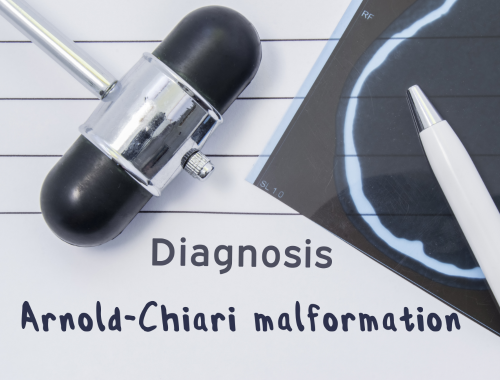Difference Between Arnold-Chiari Malformation Type 1 and Type 2
Arnold-Chiari malformation type 1 is a condition where parts of the cerebellum move through the foramen magnum at the back of the skull. Type 2 is when both the cerebellum and brain stem move through the foramen magnum.

What is Arnold-Chiari malformation type 1?
Definition:
The type 1 Arnold-Chiari malformation is a defect in the back of the skull which allows parts of the cerebellum to protrude into the spinal canal.
Causes and prevalence:
This is the most common type of Chiari malformation that occurs and is most often because of a genetic mutation. The other reason this may occur is if there is a brain tumor.
Symptoms:
The presence of symptoms depends on how severe the condition is and a person may have no symptoms at all. Where there are symptoms, these can include neck pain, head pain, feeling dizzy, having problems swallowing, and experiencing sleep apnea. Some patients develop a cyst in the spinal cord when they have this malformation.
Diagnosis:
Diagnosis is by imaging methods like CT scans and MRI scans. These can show detail of how the brain is positioned relative to the spinal canal.
Treatment:
Decompression surgery is usually needed where the problem is severe. Today, more surgeons are trying an endoscopic decompression surgical approach.

What is Arnold-Chiari malformation type 2?
Definition:
This is a condition where parts of the cerebellum and parts of the brain stem protrude into the spinal canal.
Causes and prevalence:
The type 2 malformation is commonly associated with having spina bifida, where the spinal canal and tissues have not developed normally. Arnold-Chiari malformation type 2 is a common congenital problem when there are neural tube defects.
Symptoms:
Symptoms include neck pain, trouble swallowing, blurred vision, weak muscles, headaches, balance problems, dizziness, and nausea.
Diagnosis:
An antenatal ultrasound can show abnormalities of the cerebellum of the fetus. After birth, an MRI will often show defects, including a myelomeningocele and spina bifida.
Treatment:
The treatment option depends on how bad the condition is and may include placing a shunt for hydrocephalus, closing any gaps due to spina bifida, fixing the myelomeningocele (if present), and decompression surgery at the back of the skull.
Difference between Arnold-Chiari malformation type 1 and Type 2?
Definition
An Arnold-Chiari malformation type 1 is when a part of the cerebellum pushes down into the spinal canal through the foramen magnum. An Arnold-Chiari malformation type 2 is when sections of the brain stem and cerebellum tissue push through the foramen magnum into the spinal canal.
Prevalence
The Arnold-Chiari malformation type 1 occurs most often in children. The type 2 malformation occurs in children who have spina bifida.
Causes
Arnold-Chiari malformation type 1 is caused by genetic mutations, such as the NKX2-1 gene mutation; other potential causes include tumors. The type 2 malformation happens because of a problem during fetal development, the cause of which is unknown.
Symptoms
Some symptoms of Arnold-Chiari malformation type 1 include head and neck pain, dizziness, problems with swallowing, and sleep apnea, but sometimes there are no signs. Symptoms of malformation type 2 include balance problems, nausea, dizziness, hydrocephalus, and head pain when bending over.
Treatment
The treatment of Arnold-Chiari malformation type 1 varies according to how severe the problem is and may include decompression surgery and medication for pain. The treatment of Arnold-Chiari malformation type 2 may include decompression surgery, closing of the myelomeningocele (if present), and a shunt placed to treat hydrocephalus.
Table comparing Arnold-Chiari malformation type 1 and Type 2

Summary of Arnold-Chiari malformation type 1 Vs. Type 2
- Both the Arnold-Chiari malformation type 1 and type 2 involve parts of the brain protruding through the foramen magnum.
- Decompression surgery is sometimes needed for both types of malformations depending on the severity of the condition in each case.
FAQ
Is Arnold-Chiari malformation type 1 or type 2?
Some researchers only use the term Arnold-Chiari malformation to refer to type 2, but other researchers use the term generally to refer to either type.
What is the difference between Chiari I and II on MRI?
In the case of Chiari II, the fourth ventricle of the brain and the medulla are seen to be shifted from the expected position; a myelomeningocele is also usually seen. In Chiari 1 a small amount (at least 5 mm) of the cerebellar tonsils are noted below the foramen magnum and syringomyelia are sometimes seen in the neck area.
Is Chiari malformation type 2 serious?
This condition can be serious and can result in paralysis in more severe cases.
What is a Type 2 Chiari malformation?
This malformation is when there is a problem at the back of the skull where parts of the brain (cerebellum and brain stem) pokes through into the spinal canal.
What is the prognosis of Arnold Chiari type 2?
The prognosis of this condition varies a great deal because it depends on how severe the issue is and if the person can have surgery.
Is Arnold Chiari type 1 curable?
The condition can likely be fixed through surgery.
- Difference Between Rumination and Regurgitation - June 13, 2024
- Difference Between Pyelectasis and Hydronephrosis - June 4, 2024
- Difference Between Cellulitis and Erysipelas - June 1, 2024
Search DifferenceBetween.net :
Leave a Response
References :
[0]Kuhn, James, and Prabhu D. Emmady. "Chiari II Malformation." StatPearls [Internet]. StatPearls Publishing, 2022.
[1]Kular, Sam, and Marco Cascella. "Chiari I Malformation." StatPearls [Internet]. StatPearls Publishing, 2022.
[2]Ratre, Shailendra, et al. "Endoscopic management of Arnold-Chiari malformation type I with or without syringomyelia." Journal of Neurological Surgery Part A: Central European Neurosurgery 79.01 (2018): 045-051.
